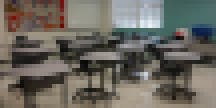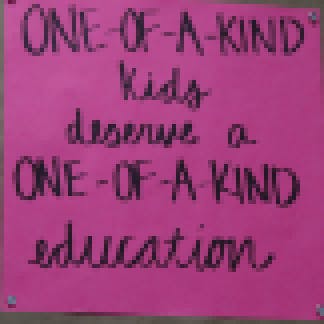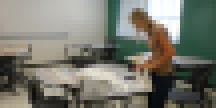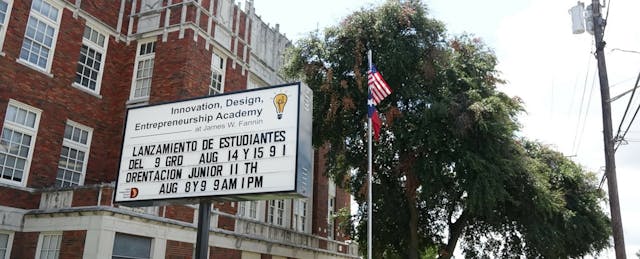The Innovation Design and Entrepreneurship Academy (IDEA) serves 330 students in grades 9 through 11. Students come to the school from 39 different Dallas neighborhoods—bringing a wide range of social-emotional experiences. Courtney Egelston, the school’s cofounder and assistant principal, learned early in her attempt to implement personalized learning that teachers had to address students' emotional needs.
“About a third of our students came from a school with a ton of trauma. Students being pepper sprayed at a middle school,” says Egelston. Another one-third of the pupils, she estimates, come from private and magnet schools. “Put them all together, and they have radically different experiences and levels of trust with educators.”
At first glance, IDEA doesn’t stand out from the other north Dallas high schools around it. The tall, red brick building with the Texas and United States flags flying high in the wind can almost be missed as massive trees cover the space. But once inside, the public charter has a startup vibe that models some of Silicon Valley’s hip coworking spaces.

“Everyone’s classroom looks so different,” says Tyler Wilkerson, an algebra teacher in her second year with IDEA. Wilkerson, similar to other teachers in the high school, she describes their school as a startup. The flexible spaces, equipped with whiteboard walls, swivel desks, and large screens in the open hallways will be familiar to anyone who has stepped foot in a tech office.
Yet re-designing the physical environment is not all that Egelston had in mind when the school opened its doors in 2015. She has been trying to cultivate a new instructional approach that focuses not just on academics, but also on the emotional well-being of students.
“About halfway through year one, a teacher said ‘we are working to personalize their academics, we need to personalize the rest of it too,’ so we looked into how we respond to student behavior and how we are coaching students,” says Egelston in an interview with EdSurge. “That led us to focus on restorative practices, and last year was our first year as a campus working to use it.”
Historians don’t necessarily agree on the origins of restorative practices but the International Institute of Restorative Practices (IIRP), a nonprofit that helps implement restorative practices in schools, traces it back to a concept popularized in the 1970s called restorative justice—"a way of looking at criminal justice that emphasizes repairing the harm done to people and relationships rather than only punishing offenders.” However, unlike restorative justice, restorative practices is not only used as a response to wrongdoing, but it is used to create climates to prevent wrongdoing from occurring, primarily by building positive relationships between actors in a space.
Egelston will be working with IIRP to further train her teachers and other staff members on restorative practices this upcoming school year. She has already been using the method to confront classroom management and behavior issues. For example, last school year a group of her students entered one of the unused hallways in the building, took out the fire extinguisher and sprayed it all over the area. The district’s code of conduct notes that their actions equate to a level three offense, meaning the students would be punished with a three-day suspension. But Egelston sat with the students and their parents to discuss who was harmed by their actions, and how they can fix the harm. They concluded that a more appropriate solution was to have the students come in for three Saturdays and help the custodian to clean up.
“As a result, I felt that their bond was stronger. They had to work together and repair the harm in a way that worked for both of them,” says Egelston.
Yet this new approach requires patience—which is sometimes in short supply. “Restorative practices is sometimes a harder sell for teachers because it’s really not easy, it is super time-consuming, but I do think that that’s key for ideas moving forward,” Egelston continues.
Egelston says that the personalized academic and classroom management practices implemented in the school are big shifts for educators coming from traditional school backgrounds. She is offering training opportunities to her teachers with IIRP, but the load has to be something teachers are willing to bear.
Twice each school year, the Dallas school district surveys teachers and staff about the climate of their school, with approximately 30 questions asking staff to rate things such as their school’s morale and employees’ relationships with school leaders. Egelston explains how difficulties implementing academic personalized learning and restorative practices took a toll on the staff. The hardship is reflected in the 2016-2017 climate survey where teachers gave the school a low 35 percent on its ability to manage unruly students who disrupted the classroom.

“Our climate surveys, our first year, before we started any restorative practices, people were in that honeymoon phase—we are a startup school, and it's so cool— they were 100 percent positive on almost every indicator. We had the number one climate survey out of 239 schools,” Egelston explains. “Then last year they were absolute garbage and were in the lowest quartile for our discipline practices. Even though some teachers were on board, it’s a learning curve.”
Before opening the school Egelston and her cofounder interviewed over one hundred applicants and settled with eight. She notes the importance of hiring wisely when trying to build a “startup” school, particularly one that adopts a highly personalized model like her own. Her preference is to hire teachers with more experience and a keen grasp of their content, noting that the steep learning curve made them lose one less-experienced teacher in the middle of the school year.
In spite of the hiccups, the teachers seem willing to take on the challenge of personalizing academics and classroom management in their classrooms. Wilkerson, says with time and practice the model has become easier for her.

“It was a difficult last year, but it will be nice this year because I feel like I have mastered a little bit more of the personalized learning," says Wilkerson.
“The push towards personalization comes from a very human approach, you cannot serve somebody if you don’t know that person,” says Egelston. “We need to know our kids and know what's going to work for them. It’s hard, but I think that what educators want to do.”


